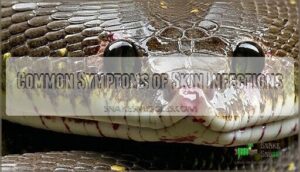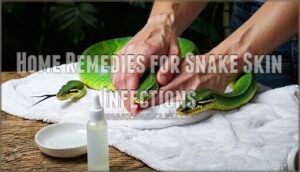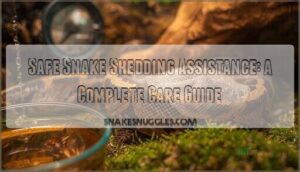This site is supported by our readers. We may earn a commission, at no cost to you, if you purchase through links.

Clean the area gently with diluted antiseptic and increase humidity—snakes love a cozy, clean home.
For mild cases, a topical antibiotic may help, but if the infection looks funky or your snake seems “off,” see a reptile vet.
Sometimes, these infections hide like a snake in the grass and need antifungal creams or prescription meds.
Never ignore persistent wounds—these critters can mask problems.
Think of your snake’s skin as its armor; proper care now means fewer battles later.
Let’s explore expert tactics next.
Table Of Contents
- Key Takeaways
- Identifying Snake Skin Infections
- Causes of Snake Skin Infections
- Home Remedies for Snake Skin Infections
- Professional Treatment Options for Severe Cases
- Preventing Future Snake Skin Infections
- Frequently Asked Questions (FAQs)
- How do you treat a snake’s skin?
- How do you treat snake fungal infections?
- Do snakes have dermatitis?
- What is bacterial skin infection in snakes?
- What happens if you don’t treat a snake’s wound?
- How do you know if a snake has a skin infection?
- What does a skin infection look like on a snake?
- How to cure snake skin at home?
- What does snake skin rot look like?
- How to treat bacterial infection in snakes?
- Conclusion
Key Takeaways
- Spot infections early – Look for red, swollen scales, fluid-filled blisters, discolored patches, or unusual shedding patterns on your snake’s skin
- Clean and adjust environment – Gently clean affected areas with diluted antiseptic, maintain proper humidity (50-60%), and keep the enclosure spotless
- Use appropriate treatments – Apply topical antibiotics for minor bacterial infections, but see a reptile vet immediately for severe cases or fungal infections
- Prevent future problems – Maintain consistent temperature gradients, practice good hygiene when handling, and conduct monthly health checks to catch issues before they worsen
Identifying Snake Skin Infections
You’ll spot snake skin infections by looking for telltale signs like discolored scales, fluid-filled blisters, and raised areas on your pet’s body.
Early detection makes treatment much more effective, so knowing what normal shedding looks like versus actual infection symptoms can save your snake‘s life, which is why early detection is crucial.
Common Symptoms of Skin Infections
Recognizing snake skin infection symptoms early makes all the difference in treatment success. Watch for these clear warning signs that demand immediate attention:
**Early detection of snake skin infections can mean the difference between a quick recovery and a life-threatening emergency.
- Skin lesions appearing as red, inflamed patches with blister formation on your snake’s ventral scales
- Scale discolor showing brown, greenish-black, or yellowish tinting that wasn’t there before
- Infection signs like raised scales with fluid pooling underneath or ruptured blisters exposing wounds
Bacterial skin infection often starts with small pustules filled with clear or yellowish fluid. These dermatitis causes create perfect entry points for deeper tissue invasion.
Snake skin lesions typically develop on areas touching bedding first. Your snake’s behavior changes too – infected snake bite wounds heal poorly, and overall lethargy signals systemic involvement.
Early detection prevents minor skin infection symptoms from escalating into life-threatening septicemia.
Types of Snake Skin Infections
Understanding the different types of snake skin infections helps you identify what’s affecting your pet.
Each infection type has distinct characteristics that guide treatment decisions.
| Infection Type | Key Characteristics |
|---|---|
| Bacterial Infections | Red, swollen blisters with pus; often yellowish fluid |
| Fungal Diseases | White patches, crusty lesions; Snake Fungal Disease causes facial swelling |
| Parasitic Infections | Visible mites or ticks; skin irritation and scratching behavior |
| Dermatitis Causes | Environmental factors; poor humidity creates various skin lesions |
| Mixed Infections | Multiple symptoms present; requires thorough antifungal medications and antibiotics |
Differentiating Between Infections and Normal Shedding
Spotting the difference between normal shedding and a snake skin infection can feel like solving a riddle.
Healthy sheds are smooth, with no leftover skin or odd patches.
Watch for these red flags:
- Unusual shedding frequency
- Dramatic skin color changes
- Blistering or bubbling scales
- Rough or raised scale texture
- Prolonged shedding duration.
These may signal Skin Lesions, Infection Signs, or Scale Problems. Understanding skin infection symptoms is vital for effective treatment and prevention.
Early Warning Signs to Watch For
Normal shedding is part of snake life, but some changes signal trouble. If you notice unusual Skin Lesions, Scale Discoloration, or Blister Formation, these could be early warning signs of a snake skin infection.
Watch for these symptoms:
- Lethargy or sluggish movement
- Redness, swelling, or inflamed areas
- Discharge, crusty patches, or oozing wounds
- Loss of appetite or reluctance to eat
Prompt action helps prevent minor issues from becoming serious skin infection symptoms, and it is crucial for maintaining the overall health of your snake, especially in cases of Lethargy.
Causes of Snake Skin Infections
Understanding what causes snake skin infections helps you prevent these painful conditions before they develop.
Several factors can compromise your snake’s skin health, from environmental problems to parasitic invaders that exploit weakened defenses.
This includes understanding the role of environmental factors in skin health.
Environmental Factors Contributing to Infections
In the context of snake health, your pet’s environment sets the stage for either healing or harm.
Dirty enclosures and poor ventilation turn a cozy home into a hotspot for bacteria and fungi.
Humidity control and temperature management are essential—too much moisture or fluctuating temps invite trouble.
- Substrate sanitation and regular cleaning prevent environmental contamination.
- Outdoor equipment and contaminated soil can introduce harmful microbes, so always check for cleanliness before use.
Proper snake care involves understanding common snake diseases to prevent infections.
Poor Husbandry and Its Impact
Poor husbandry creates the perfect storm for snake skin infection.
When you skimp on enclosure maintenance, humidity control, or temperature management, you’re compromising your snake’s reptile skin health.
Dirty substrates, irregular cleaning schedules, and inconsistent husbandry practices weaken immune defenses.
These lapses trigger environmental dermatitis and various snake skin conditions, making your pet vulnerable to serious infections.
Parasitic Causes of Skin Infections
Parasites pose serious threats beyond poor husbandry conditions. Mite infestations from Ophionyssus natricis cause severe dermatitis and anemia in captive snakes. Tick exposure leads to blood loss and secondary bacterial infections. Protozoan infections create skin lesions through tissue damage.
Mite and tick infestations can quickly turn your snake’s skin from healthy to dangerously damaged—protection starts with prevention.
These snake skin parasites spread rapidly through direct contact:
- Snake mites hide in skin folds and around eyes, causing crusting dermatitis
- Nematode hookworms penetrate skin, creating open wounds and ulcerations
- Filarioid worms migrate through tissue, forming painful blisters
Parasitic infections require immediate parasite control measures to prevent septicemia and death. Effective reptile mite treatment is essential to prevent the spread of parasites and reduce the risk of infection.
Bacterial and Fungal Culprits
Bacterial pathogens like Pseudomonas and Staphylococcus create bacterial skin infections through wounds or compromised immunity.
Fungal infections from Ophidiomyces ophiodiicola cause scale rot and dermatitis. Both thrive in humid environments with poor sanitation.
| Pathogen Type | Common Species | Primary Symptoms |
|---|---|---|
| Bacterial | Pseudomonas, Staphylococcus | Skin lesions, pustules |
| Fungal | Ophidiomyces ophiodiicola | Scale rot, facial swelling |
| Mixed | Various combinations | Severe dermatitis, septicemia |
Antifungal medications and bacterial infection treatment require veterinary guidance for effective recovery.
Home Remedies for Snake Skin Infections
When minor skin infections strike your snake, you don’t always need expensive veterinary treatments to help them recover.
Simple home remedies can effectively address early-stage infections while you monitor your pet’s progress and decide if professional care becomes necessary, utilizing simple techniques to aid in recovery.
Safe Cleaning and Disinfection Methods
A clean home is your snake’s first defense against infection.
Stick to these evidence-based Cleaning Protocols:
- Use reptile-safe Disinfectant Solutions—skip harsh household cleaners.
- Scrub enclosures weekly for proper Enclosure Maintenance.
- Practice good Hygiene Practices—always wash hands before and after handling.
- Sanitize water bowls daily with antiseptic solutions like betadine for effective wound disinfection and overall Sanitizing Methods.
When selecting a disinfectant, consider using a reptile disinfectant to guarantee the health and safety of your snake, and follow these guidelines for proper care.
Proper Humidity and Temperature Control
Creating ideal humidity levels between 50-60% prevents bacterial growth while supporting healthy shedding.
Your temperature gradient should range from 75°F cool side to 88°F basking spot.
Use digital hygrometers for accurate moisture management and ceramic heat sources for consistent temperature regulation.
Proper ventilation systems prevent stagnant air without eliminating necessary humidity.
Monitor enclosure sanitation daily, as incorrect temperature control weakens your snake’s immune system and promotes infection.
Topical Treatments for Minor Infections
For minor snake skin infections, you’ll want safe and proven treatments.
Apply antiseptic solutions like diluted povidone-iodine to clean skin lesions gently.
Follow with thin layers of antibiotic ointments containing bacitracin or neomycin twice daily.
These topical antibiotics combat bacterial growth while promoting healing.
Always clean wounds thoroughly before applying treatments, and monitor for improvement within 3-5 days.
Using the right antibiotic products is essential for effective treatment.
Dietary Adjustments to Boost Immune System
During recovery, your snake’s diet becomes essential for fighting infection. Proper nutrition strengthens immune defenses and accelerates healing through targeted Nutrient Supplements and Immune Boosters.
Healthy Feeding strategies include:
- Vitamin Support with A and D3 supplements for skin regeneration
- Calcium supplementation to maintain overall health during stress
- Balanced Diet with gut-loaded feeder insects for ideal nutrition
- Mineral supplements containing zinc and selenium for immune function
- Address nutritional deficiencies through vitamin supplements targeting specific dietary requirements
Creating a Stress-Free Recovery Environment
Your snake needs quiet spaces and calming environments during recovery.
Minimize handling and create healing chambers with multiple hiding spots.
Maintain proper humidity control for ideal reptile skin health.
Keep noise levels low around recovery tanks to support stress reduction and enhance the wound healing process.
These environmental improvements accelerate healing substantially.
Professional Treatment Options for Severe Cases
If your snake’s skin infection doesn’t improve or worsens, you’ll need to seek professional veterinary care.
Advanced cases require diagnostic testing, prescription medications, and sometimes surgical intervention to prevent serious complications.
When to Seek Veterinary Care
Home remedies help, but professional intervention becomes necessary when infections worsen.
Seek reptile vet consultation immediately if you observe these critical warning signs:
- Systemic Symptoms – Lethargy, loss of appetite, or breathing difficulties indicate infection severity beyond homecare
- Wound Severity – Deep lesions, extensive discharge, or rapid deterioration require immediate medical attention
- Unresponsive Homecare – No improvement after 3-5 days of proper treatment suggests professional intervention needed
- Preventative Checkups – Annual exams help catch early warning signs before snake skin infection becomes life-threatening
Diagnostic Procedures for Snake Skin Infections
Veterinarians employ thorough snake skin infection diagnosis methods to identify the exact cause.
Visual examination reveals surface symptoms, while Scale Cytology analyzes cellular changes under microscopy.
Laboratory tests include Culture Methods for bacterial identification and Fungal Identification through specialized testing.
Parasite Screening detects mites or other ectoparasites.
Biopsy Analysis provides definitive tissue diagnosis when needed.
| Diagnostic Method | Purpose |
|---|---|
| Scale Cytology | Identifies inflammatory cells and pathogens |
| Culture Testing | Isolates specific bacterial or fungal organisms |
| Parasite Screening | Detects mites, ticks, and other ectoparasites |
Your snake skin veterinarian combines these techniques for accurate diagnosis and targeted treatment planning.
Prescription Medications and Their Usage
When severe infections strike, prescription medications become your strongest allies.
Antibiotic dosage varies by species—azithromycin at 10mg/kg every 3-7 days works well for skin infections. Antifungal types like azoles target stubborn fungal problems effectively.
Deworming protocols using praziquantel eliminate parasitic causes. Topical application of silver sulfadiazine fights bacterial dermatitis directly.
Early intervention with nebulization therapy can also prove beneficial. Monitor for medication side-effects and follow your vet’s timeline precisely—consistency determines success.
Surgical Interventions for Advanced Infections
When medication fails, advanced infections require surgical intervention.
Your veterinarian may perform debridement techniques to remove dead tissue, abscess removal through precise incision technique, or drainage methods for fluid-filled lesions.
Wound care protocols follow immediately.
Grafting options help repair extensive damage, while amputation risks exist for severely infected areas requiring post-surgical care.
Surgical procedures include:
- Sterile debridement – removing necrotic scales and infected tissue layers
- Abscess drainage – creating controlled openings to release trapped infection
- Tissue reconstruction – rebuilding damaged skin areas with healthy grafts
- Laser cauterization – sealing blood vessels and preventing further bacterial spread
- Microsurgical repair – restoring function to affected body segments
Follow-up Care and Monitoring
Post-surgical success depends on diligent wound monitoring and strict medication schedule adherence.
Daily wound inspection reveals healing progress or complications.
Behavior changes like appetite loss signal problems requiring immediate veterinary consultation.
Environmental adjustments maintain favorable recovery conditions.
Regular monitoring prevents reinfection through consistent follow-up care.
Health monitoring and preventative measures guarantee long-term recovery success.
Preventing Future Snake Skin Infections
Once you’ve successfully treated your snake’s skin infection, you’ll want to focus on prevention strategies to keep it from coming back.
The key is maintaining ideal husbandry conditions and staying vigilant about your snake’s health through regular monitoring and proper care routines.
Optimizing Enclosure Hygiene and Maintenance
Through daily vigilance and systematic cleaning protocols, you’ll transform your snake enclosure into a fortress against snake skin infection.
Substrate selection matters—choose paper towels or cypress mulch over cedar shavings. Maintain water quality by changing bowls twice weekly and installing proper ventilation systems.
Disinfectants like diluted bleach solution work wonders for weekly deep cleans. Proper cleaning requires effective snake disinfectants.
Remember, enrichment impact extends beyond toys—clean hides prevent bacterial buildup. Your snake hygiene routine becomes second nature when infection prevention drives every decision you make.
Regular Health Check-ups and Examinations
Vigilance serves as your snake’s first line of defense against skin infections. Conduct thorough examinations monthly to catch problems early.
- Visual Inspections: Check scales for discoloration, blisters, or abnormal shedding patterns
- Palpation Techniques: Gently feel for unusual bumps, swelling, or texture changes
- Weight Monitoring: Track weight fluctuations that indicate health changes
- Behavior Observation: Document appetite, activity levels, and shedding cycles for your veterinarian
Proper Handling Techniques to Minimize Stress
Stress affects your snake’s immune system, making skin infections more likely.
Gentle restraint using both hands prevents injury while supporting the snake’s body weight. Create a calm environment by moving slowly and avoiding sudden noises.
Reading cues like defensive posturing means it’s time to stop handling. Use gradual introduction with new snakes, allowing them to adjust before extended sessions.
Support techniques involve distributing weight evenly – never grab just the head or tail. Proper husbandry practices include washing hands before handling to prevent bacterial transfer.
These handling techniques reduce cortisol levels, supporting natural snake skin treatment and overall health, which is essential for overall health.
Balanced Nutrition for Healthy Skin
Your snake’s diet directly impacts skin health and prevents snake skin infection.
Essential Vitamins like A and D3 support cellular repair, while proper Hydration Importance can’t be overstated for healthy shedding.
Food Variety matters – whole prey provides complete nutrition that supplements can’t match.
Gut Health flourishes with consistent feeding schedules and appropriate prey sizes.
Consider Supplement Options only when deficiencies exist.
Trace minerals are important for scale integrity.
Poor snake malnutrition weakens immune defenses, making effective snake skin treatment harder and snake skin remedies less successful for overall snake health.
Recognizing and Addressing Potential Health Risks
The key to preventing snake skin infection lies in proactive monitoring and swift action.
Early detection helps catch problems before they escalate into serious health issues.
- Daily health assessments – Check for discoloration, raised scales, or unusual behavioral changes that signal snake skin infection symptoms
- Quarantine importance – Isolate new reptiles for 30-60 days to prevent introducing pathogens that cause snake skin infection
- Husbandry adjustments – Monitor temperature, humidity, and cleanliness while implementing stress reduction techniques for effective snake skin infection prevention
Frequently Asked Questions (FAQs)
How do you treat a snake’s skin?
Keep it clean, keep it dry, keep it safe—wash gently with antiseptic, monitor for redness or blisters, adjust humidity, and swap soiled bedding for fresh.
If wounds or swelling show, get a reptile vet’s advice quickly.
How do you treat snake fungal infections?
Antifungal medications like azoles target fungal infections, though you’ll need supportive care since treatment success varies.
Clean wounds with antiseptic solutions, maintain proper humidity levels, and consult your veterinarian immediately for proper diagnosis and medication protocols.
Do snakes have dermatitis?
Yes, your reptile buddy can get dermatitis, just like you might get a rash after hiking.
It usually shows up as red, irritated skin with blisters or ulcers.
Poor hygiene or excess moisture often plays the villain.
What is bacterial skin infection in snakes?
Coincidentally, when your snake’s skin looks inflamed, you’re likely seeing bacterial dermatitis. Harmful bacteria invade compromised skin through wounds, creating infected blisters and discolored scales that can spread systemically.
What happens if you don’t treat a snake’s wound?
Untreated snake wounds rapidly deteriorate into serious bacterial infections. You’ll see septicemia develop, where bacteria enters the bloodstream, causing lethargy and potentially fatal systemic illness requiring emergency veterinary intervention.
How do you know if a snake has a skin infection?
Roughly 70% of captive snakes develop skin infections during their lifetime.
You’ll spot red, inflamed scales with fluid-filled blisters, especially on the belly.
Look for discolored patches, raised scales, or facial swelling that signals trouble brewing.
What does a skin infection look like on a snake?
Snake skin infections appear as fluid-filled blisters, discolored scales (brown, greenish-black, red, yellow), raised scales, and inflamed red skin.
You’ll notice pustules on the belly side, where your snake contacts bedding most, which can be a clear indication of a skin infection.
How to cure snake skin at home?
Like watching paint dry in reverse, home treatment can’t cure serious snake skin infections.
You’ll need veterinary antibiotics for bacterial dermatitis, antifungal medications for fungal diseases, and proper husbandry corrections to prevent reinfection, which includes understanding and applying proper husbandry.
What does snake skin rot look like?
You’ll spot raised, discolored scales appearing brown, yellow, or blackish-green. Blisters form underneath scales, creating fluid-filled bumps on the belly. These lesions rupture, exposing raw wounds that spread if untreated.
How to treat bacterial infection in snakes?
You’ll need oral or injectable antibiotics from a veterinarian to treat bacterial infections effectively.
Clean affected areas with antiseptic solutions, improve enclosure humidity and cleanliness, and monitor daily for healing progress.
Conclusion
Just like a knight depends on sturdy armor, your snake relies on healthy skin for protection.
Knowing how to treat snake skin infection means spotting symptoms early, maintaining proper humidity, and using evidence-based care.
Don’t hesitate to consult a reptile vet for persistent or severe cases, and by staying alert and proactive, you’ll reduce complications and keep your snake thriving.
Remember, prevention and prompt action are your best tools for managing and avoiding snake skin infections effectively.
- https://www.fws.gov/question-answer/understanding-snake-fungal-disease-impacts-treatments-and-prevention
- https://cwhl.vet.cornell.edu/article/everything-you-wanted-know-about-snake-fungal-disease-were-afraid-ask
- https://vcahospitals.com/know-your-pet/snakes-diseases
- https://www.wildlifedemonstrations.com/post/scale-rot-how-to-identify-and-treat
- https://veterinarypartner.vin.com/default.aspx?pid=19239&catId=102919&id=8453042&ind=1243&objTypeID=1007

















